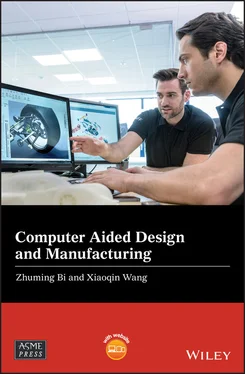22 Foster, I. (1995). Parallelism and computing. https://www.mcs.anl.gov/∼itf/dbpp/text/node7.html.
23 Goel, A.K. (1997). Design, analogy, and creativity. https://pdfs.semanticscholar.org/29ed/10edb3e1e65ded62c58577d3e2fd13a8f2cf.pdf.
24 Gold, S. (2016). Manufacturing's economic impact: so much bigger than we think. https://www.mapi.net/blog/2016/02/manufacturings-economic-impact-so-much-bigger-we-think.
25 Harish, A. (2018). Cloud solution in the world of CAD and CAE. https://www.simscale.com/blog/2017/05/cloud-solutions-secure.
26 IEC (2019). Factory of the future. https://www.iec.ch/whitepaper/pdf/iecWP-futurefactory-LR-en.pdf.
27 International Trade Centre (ITC) (2019). Global Value Chains in Services: A Case Study on Costa Rica. Geneva: ITC, 2014. vi, 17 pages. Doc. No. DMD‐14‐257.E. http://www.intracen.org/uploadedFiles/intracenorg/Content/Publications/AssetPDF/cover%20Global%20Value%20Chains%20in%20Services%20-%20a%20Case%20Study%20of%20Costa%20Rica.pdf.
28 Kniivila, M. (2018). Industrial development and economic growth: implications for poverty reduction and income inequality. http://www.un.org/esa/sustdev/publications/industrial_development/3_1.pdf(last accessed on 24 April 2018).
29 Li, H., and Williams, T.J. (1994). A formalization and extension of the Purdue Enterprise Reference Architecture and the Purdue Methodology. http://www.ict.griffith.edu.au/∼bernus/taskforce/archive/pera/hong/THESIS-HONG-LI.pdf.
30 MathWorks (2018) What is hardware‐in‐the‐loop simulation? https://www.mathworks.com/help/physmod/simscape/ug/what-is-hardware-in-the-loop-simulation.html.
31 Microsoft (2019). What is cloud computing? https://azure.microsoft.com/en-us/overview/what-is-cloud-computing.
32 Moravec, H. (1998). When will computer hardware match the human brain. Journal of Evolution and Technology 1: 1–12. https://jetpress.org/volume1/moravec.pdf.
33 Morley, M. (2014). The evolution of the digital manufacturing business. https://blogs.opentext.com/the-evolution-of-the-digital-manufacturing-business-2.
34 Nilsson, T. L. (2014). Why am I learning this? Using everyday examples in engineering to engage female (and male) students in the classroom. The 121 ASEE Annual Conference and Exposition, Indianapolis (15–18 June 2014), paper ID #10398.
35 Ortiz, A., Lario, F., and Ros, L. (1999). Enterprise integration – business processes integrated management: a proposal for a methodology to develop enterprise integration programs. Computers in Industry 40 (1999): 155–171.
36 Savage, T.M. and Vogel, K.E. (2013). An Introduction to Digital Multimedia, 2e. Jones & Bartlett Learning, ISBN‐10: 144968839X.
37 Sotala, K. (2012). Advantages of artificial intelligences, uploads, and digital minds. International Journal of Machine Consciousness 4 (1): 275–291. https://doi.org/10.1142/S1793843012400161.
38 Source Weekly (2012). Traditional heavy metal: blacksmithing and Rock 'N Roll are both alive and well at Orion Forge. https://www.bendsource.com/bend/traditional-heavy-metal-blacksmithing-and-rock-andaposn-roll-are-both-alive-and-well-at-orion-forge/Content?oid=2140249.
39 Wang, X. and Bi, Z.M. (2018, 2018). New CAD/CAM Course Framework in Digital Manufacturing. Computer Applications in Engineering Education: 1–17. https://doi.org/10.1002/cae.22063.
40 Wang, C., Bi, Z.M., and Xu, L.D. (2014). IoT and cloud computing in automation of assembly modeling systems. IEEE Transactions on Industrial Informatics 10 (2): 1426–1434.
41 Wikipedia (2017). Three‐sector theory. https://en.wikipedia.org/wiki/Three-sector_theory.
42 Wikipedia (2019a). Manufacturing. https://en.wikipedia.org/wiki/Manufacturing.
43 Wikipedia (2019b). Computer memory. https://en.wikipedia.org/wiki/Computer_memory.
44 Wikipedia (2019c) Distributed database. https://en.wikipedia.org/wiki/Distributed_database.
45 Wikipedia (2019d). Virtual enterprise. https://en.wikipedia.org/wiki/Virtual_enterprise.
46 Wikiversity (2019). Computer‐aided design/history, present and future. https://en.wikiversity.org/wiki/Computer-aided_design/History,_Present_and_Future.
47 Wole, A. (2018). The evolution: computer input and output. https://shopinverse.com/blogs/technology/the-evolution-computer-input-and-output.
48 Wu, D. (2014). Cloud‐based design and manufacturing: a network perspective. PhD thesis. Georgia Institute of Technology. https://smartech.gatech.edu/bitstream/handle/1853/53029/WU-DISSERTATION-2014.pdf.
49 Wu, D., Rosen, D.W., Wang, L., and Schaefer, D. (2015). Cloud‐based design and manufacturing: a new paradigm in digital manufacturing and design innovation. Computer Aided Design 59: 1–14.
Part I Computer Aided Design (CAD)
2 Computer Aided Geometric Modelling
2.1 Introduction
Any matter for an object in the world exists in one of four distinct states, i.e. solid , liquid , gas , and plasma . The solid state is a common state for the majority of products around us. To investigate the behaviours of solids, it is necessary to know its geometry and shape. Similarly, to investigate the behaviours of fluid, gas, or plasma in a certain volume, the geometry and shape of boundary surfaces of a fine volume is also needed to be defined.
For centuries, geometry has played its crucial role in the development of many scientific and engineering disciplines such as astronomy, geodesy, mechanics, ballistics, civil and mechanical engineering, ship building, and architecture. The importance of the study on geometry has been shown in this century in automobile and aircraft manufacturing. Since geometry is primarily visual, geometry becomes a unique and particularly exciting branch of mathematics. Geometry became a branch of mathematics at the end of the nineteenth century; however, great designs in the history were always inspired by observation and intuition on geometric shapes (Gallier 2008). Geometric modelling is a branch of applied mathematics and computational geometry ; it studies the methods and the algorithms for the mathematical representation of geometries and shapes. Geometric modelling serves for the visualization of objects and lays the foundation for computer graphics , which is the construction of models of scenes from the physical world and their visualization as images.
Geometric modelling is as important to computer aided technologies as the governing equilibrium equations are to classical engineering fields such as mechanics and thermal fluids. As shown in Figure 2.1, the design of a part, product, or system usually begins with geometric modelling, so that the physical objects to be designed can be represented virtually in computers. Geometric modelling techniques and algorithms are used to model objects, and the dimensions and spatial constraints of objects are inputs via graphic user interfaces (GUI) of modelling tools. Once the objects are modelled, any information associated with the objects can be utilized in the design processes or decision‐making supports involved in a product lifecycle. For example, virtual geometric models can be used by computer graphics to visualize the designs before physical products are made. Engineering drawings needed in manufacturing processes can be directly generated from solid models of products, and all of the annotations relating to dimensioning and tolerance can be included in the drawings. If a product is a machine with relative motions among system components, a motion study can be defined upon the computer aided design (CAD) model to investigate the relations of driving forces and motions. In addition, engineering analysis can be performed at any stage of the product design process. In the following chapters, you will learn how virtual models of products can be utilized to solve design problems in mould designs, engineering analysis, simulation of manufacturing processes, evaluation of system sustainability, and so on.
Читать дальше












